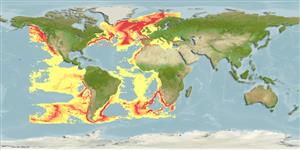Common names from other countries
Environment: milieu / climate zone / depth range / distribution range
Ecologie
Rifbewoner; diepteverspreiding 27 - 4312 m (Ref. 105406). Subtropical; 75°N - 58°S, 145°W - 36°E
Eastern Pacific, Atlantic Ocean, Mediterranean Sea to the Arctic: Western to northern Europe, and Western Africa.
Length at first maturity / Size / Gewicht / Leeftijd
Maturity: Lm ? range ? - ? cm Max length : 2.0 cm SHH mannelijk/geslacht niet bekend; (Ref. 90120)
Inhabits deep-water coral reef mound (Ref. 105183). It is also found in sublittoral to abyssal depths, usually attached to rocks, stones, gorgonians, or hydroids on muddy and sandy substrates (Ref. 90120). Epibionts on the trunk of the black coral Leiopathes glaberrima bush (Ref. 105183). Colonized by the parasitic foraminifer Hyrrokkin sarcophaga (Ref. 105186). Suspension feeder (Ref. 105183). In general, suspension feeding bivalves mainly depend on phytoplankton and detritus material for nutrition (Ref. 107088).
Life cycle and mating behavior
Geslachtsrijpheid | Voortplanting | Kuitschieten | Eieren | Fecundity | Larven
Members of the class Bivalvia are mostly gonochoric, some are protandric hermaphrodites. Life cycle: Embryos develop into free-swimming trocophore larvae, succeeded by the bivalve veliger, resembling a miniature clam.
Demir, M. 2003. (Ref. 2754)
Status op de Rode Lijst van het IUCN (Ref. 130435)
Status bij CITES (Ref. 108899)
Not Evaluated
Not Evaluated
Gebruik door de mens
| FishSource |
Tools
Meer informatie
Leeftijd/Grootte
Groei
Lengte-gewicht parameters
Lengte-lengte parameters
Morfologie
Larven
Abundantie
Internet-bronnen
Estimates based on models
Preferred temperature
(Ref.
115969): 2.6 - 8.7, mean 4 (based on 528 cells).
